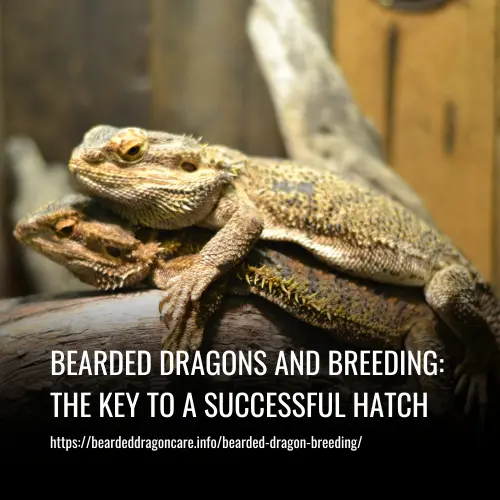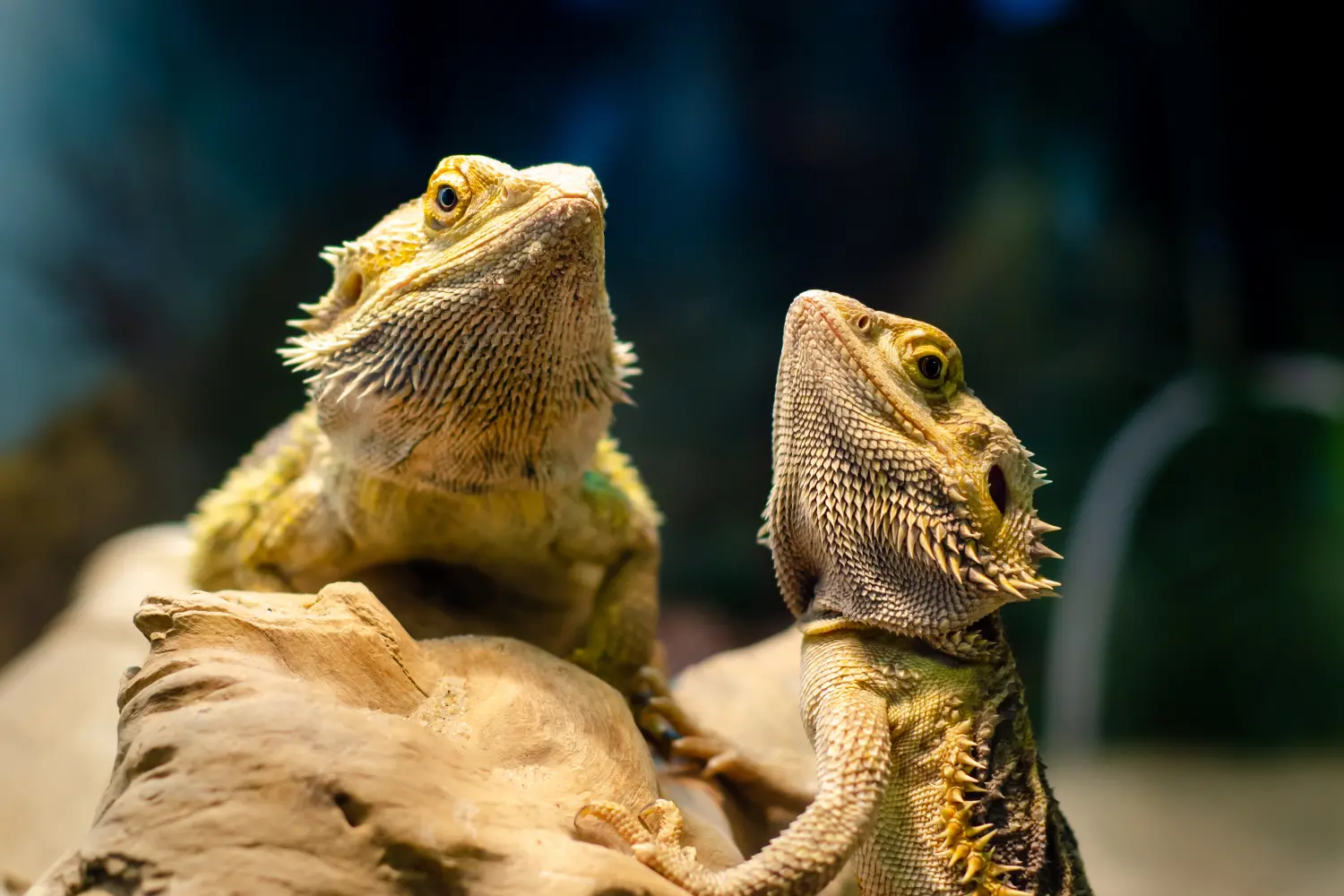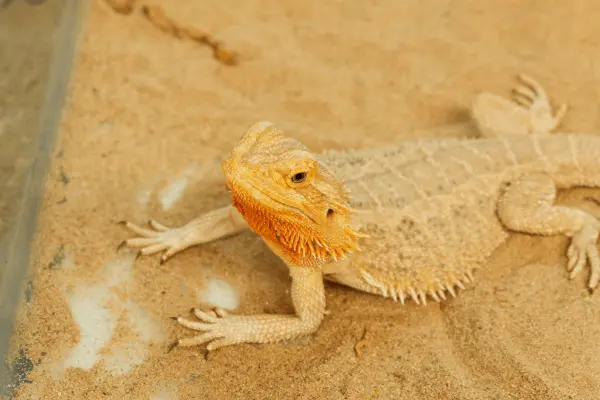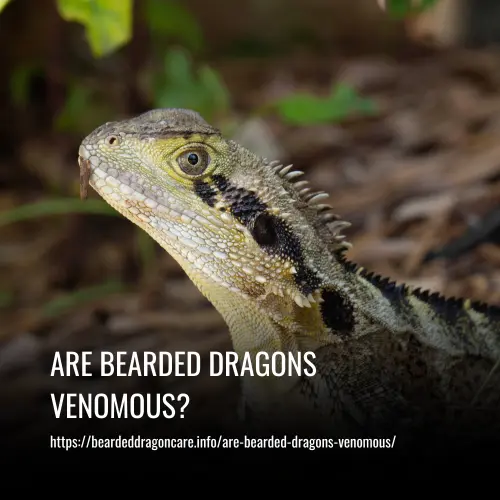Bearded Dragons have become some of the most popular reptiles to own as pets. With their curious nature, it’s understandable why they are so sought after!
For any Beardie owner that is interested in learning how to breed their pet lizards, it takes more than just having a male and female. Many factors must be considered before attempting to breed.
In this article, we’ll talk about bearded dragon breeding basics including care, health requirements, incubation techniques, and more!

Preparing Your Dragons for Breeding
If you want to prepare your dragons for breeding, you must start by paying close attention to their health and nutrition. Feeding your lizards heavily and ensuring they are in good overall health is key. Male dragons should have healthy body weights without being obese, while females can have a little extra fat but should not be overfed as this seldom leads to successful breeding.
In addition, scheduling a veterinary visit prior to pairing or cycling is highly recommended. This way, any potential illnesses or infections can be identified and treated before the lizards start their mating process.
Finally, female dragons will need a lot of nourishment throughout their cycle. After they’ve bred, they must carry the eggs and consume enough food to support them during the development phase before burying them in a large hole at the end of it all!
Sexing Bearded Dragons
Sexing a Bearded Dragon can be difficult, especially when they are younger than 3 months old. That’s why it’s important to recognize the distinct signs which will tell you whether it’s a male or female.
Adults are easy to sex — Males have larger and more rounded heads with larger beards, while females have thinner and narrow head. Juveniles may not show this difference in size, so it’s best to look at the rear legs. Males will have dark dots called femoral pores that are much more noticeable compared to females.
You can also check for hemipenal bulging which is absent in females. To do this, carefully hold the dragon and lift their tail up over their back so that you can see the vent/cloacal opening between their legs. If you see two bulges on either side of the base of the tail after the vent with an indentation in between, then your dragon is likely male.
When Can You Breed Bearded Dragons?
When it comes to breeding Bearded Dragons, age is everything. It’s best to wait until your dragons are at least 18 months old before attempting to breed them; any younger and you may risk the health of your female.
She could become infertile or egg-bound, both of which can be incredibly dangerous conditions for her – in some cases, it may even lead to death or require a vet to perform surgery on her! Therefore, make sure you wait until your dragons are nice and mature before attempting to breed them.
Sexual Maturity [Age for Breeding]
Sexual maturity for female bearded dragons is determined by their physical size, not age. In the wild, these reptiles may reach a breeding age between one and two years old. However, under conditions of captivity and with access to better food sources and habitats, female bearded dragons can become sexually mature before a year of age if they reach the appropriate size.
Once a female reaches sexual maturity, she becomes vitellogenic and can become gravid – meaning she’s fertile and able to lay eggs – from spring until early summer.
According to Journal of the Royal Society of Western Australia, wild female Pogona minor can reach sexual maturity once they measure 90 millimeters in snout-vent length; additionally, according to Stauber & Booth (2003), females of Pogona barbata are considered sexually mature when their snout-vent length is between 110.5 and 119.5 millimeters. It should be noted that males grow larger than females in this species.
| Pogona species – Females | Sexual Maturity |
| Pogona minor (small bearded dragon’s) | 90 mm |
| Pogona barbata (large bearded dragon’s) | 110.5-119.5 mm |
When it comes to breeding, male bearded dragons (Pogona barbata) become sexually mature when they reach a snout to vent length of between 127.5 mm and 135.5 mm, while wild male Pogona minor is sexually mature at 80 mm snout to vent length. Male beardies stay fertile all year round asides from a short time in late summer.
On the other hand, female bearded dragons can lay eggs without a partner present as part of the normal reproductive cycle; however, if there hasn’t been a mate within the breeding season, the eggs will not be fertile.
But with their ability to store sperm in oviductal crypts within a single season, females can lay clutches of potentially-fertile eggs even without multiple mating sessions. To ensure that you know exactly which male fathered any particular hatchling, only let one male mate with your female throughout the breeding season.
| Pogona species – Males | Sexual Maturity |
| Pogona minor (small bearded dragon’s) | 80 mm |
| Pogona barbata (large bearded dragon’s) | 127.5-135.5 mm |
How to Breed Bearded Dragons: The Steps
Generally, breeders follow some basic steps when it comes to breeding. These stages can be altered according to the breeder’s preferences or environment. After becoming familiar with these steps, you can customize them as needed based on your own expertise.
1. Acquire Your Mating Pair
Having the perfect mating pair for your bearded dragons is essential! To do this, you need to be able to properly sex your dragons accurately. Fortunately, it’s quite simple if you know what to look for.
First, check the cloaca or vent between their hind legs. Male bearded dragons have two small bulges on either side while females will not. Additionally, males typically also have larger and darker beards than females. This can be easily determined by comparing male and female dragons side by side.
Besides this visible difference in appearance, males usually also tend to be bigger and heavier than females. By gently holding up each dragon and observing the region near their cloaca and hind legs, you can then look for large femoral and perianal pores which are much more pronounced on a male dragon compared to a female’s barely visible ones.
2. Maintain Perfect Health
Maintaining perfect health is essential if you want to breed bearded dragons. You need to monitor the nutrition of your dragons closely and make sure they are at their optimum weight. Too much or too little can impede their ability to successfully mate.
Additionally, you’ll need to ensure that your female bearded dragon gets enough calcium and vitamin D in her system before brumation begins. Egg production requires a lot of calcium, which is drawn directly from her bones! A lack of calcium can cause metabolic bone disease and a decreased lifespan for your female dragon.
3. Brumation
Brumation is an essential part of a bearded dragon’s life cycle. It is the period during which they go somewhat dormant and prepare themselves for springtime, typically lasting anywhere between two to three months. During this time, it is important to mimic their natural environment by gradually reducing light and heat in their enclosure.
Their normal photocycle should be 12/12; reducing this to 8 hours of light and 16 hours of darkness will simulate wintertime. As well as adjusting the amount of light, it is also important to reduce overall temperatures; while they are usually maintained at 90°F at the basking spot and 75°F on the cool end, during brumation these figures should slowly be reduced until the cool end reads 65°F and warm end reads 75°F.
It is paramount that all changes take place slowly and carefully in order to avoid any kind of stress or health issues arising from navigating these phases too quickly; introducing sudden changes can lead not only to unsuccessful mating but in some cases death. By following these guidelines, however, your bearded dragons will emerge from brumation healthy and ready for spring!
4. Mating Rituals
Mating rituals in dragons are fascinating and intricate. After they have finished the period of brumation, it’s time to give them a good meal and then put the female inside the male’s enclosure. Remember to keep watch, as there may be signs of aggressive behavior towards one another.
Males and females both display different behaviors that show when they are ready to mate. Generally, males will display their dominance by stamping their feet, fluffing up their beards, darkening them, and bobbing their heads. The female dragon will arm wave if she is receptive and then the male will chase her a bit before biting her on the neck in an attempt to Mate with her.

5. Mating
Mating between bearded dragons can be a tricky process. The male will usually bite the female on the back of her head in order to initiate mating, and she may try to get away. If at any point you feel that she is terrified and trying to escape, simply take her out of the enclosure and wait a day or two before trying again.
Once successful mating has taken place, it’s important to remember that you must separate them permanently – it’s for their safety, as well as for any future hatchlings! Make sure that you are fully prepared for your female dragon’s aftercare, too; ensure that her enclosure is appropriate for raising baby dragons!
6. Waiting and Preparing for Eggs
When it comes to waiting and preparing for eggs, there are certain steps that need to be taken in order to ensure the female lays her eggs safely. Prior to starting, the female needs to be given proper nutrition in order for her to stay healthy and for the eggs inside of her to develop.
In time, you should start to notice her belly rounding out slightly, and when you get close enough, you can even see the outline of each egg! At this point she will start looking for somewhere suitable to lay her eggs – this is your cue to provide her with an egg box.
The egg box should be big enough for the female’s gravid belly and filled with a mix of soil and perlite. This is important because the soil holds moisture well and keeps its shape when being dug up. After introducing the female to the box, watch how she explores it and digs corners before selecting which one suits her best. Once she settles down in her chosen corner, soon enough she will start laying eggs!
7. Removal of Eggs
When it comes time to remove the eggs from your female’s enclosure, there are a few things you should keep in mind.
Firstly, once she has laid and covered them with sand, treat her to a nice bath and some food for relaxation. Once she is happy and content, it is safe to gently remove the egg box from the enclosure.
When handling the eggs, remember to delicately remove any sand and be sure not to turn or move them from the position they were found in. Marking their tops with a soft pencil will help you remember where they were placed originally.
When you observe any two eggs stuck together, don’t try to pull them apart since this may injure the egg and embryo.
Instead, place these adhered eggs directly into your incubator so they remain undisturbed. With these steps in mind, you can now safely begin removing the eggs from your pet’s enclosure!
8. Egg Incubation
Egg Incubation is a simple but important step in the process of hatching embryos. For successful hatching, you’ll need to have a dependable egg incubator. For beginners, it’s best to purchase a commercially manufactured incubator as opposed to building your own.
Aside from keeping an incubator, you should also have containers that fit into it for holding the eggs. Utilize plastic food storage containers with only a single or two small air holes on the lid. Fill the boxes with damp vermiculite and place the eggs carefully half-buried within, keeping them in the same position they were discovered in (marked if necessary).
To achieve optimal results, aim for an incubation temperature of about 84 – 86 degrees Fahrenheit. Generally speaking, bearded dragon eggs will hatch around 55 to 75 days under these conditions; however, some may take longer so never discard viable and healthy eggs prematurely!
9. Hatchling Care
When it comes to hatchling care, it’s important to make sure you do everything correctly. If you do, then one day you’ll be able to see little baby dragons running around in an egg box. It’s important not to remove them from their eggs unless they haven’t been out for a period of 48 hours after pipping as this can cause serious harm.
To ensure the proper growth and development of your hatchlings, you need to set up a special habitat for them that is similar to an adult dragon’s habitat but scaled down. Using newspaper or paper towel substrate would be wiser than using other materials and the environment should be kept more humid when compared to adults.
It would take a few days for the newly hatched lizards to adjust to the new surroundings so it is wise not to start feeding them straight away. To avoid dehydration, mist them with room-temperature water at least twice or thrice a day.
Once they are old enough, crickets should be served as a meal as most of the time they tend to resist vegetable matter initially. Provide food once a day till they get accustomed and later on feeding them three times a day accordingly.
Breeding Bearded Dragon care
How to look after a Pregnant Bearded Dragon
When a bearded dragon is pregnant, it’s important to review the calcium supplementation and vitamin D3 levels. Ensure that their heating and lighting are functioning properly. It’s also essential to prepare a digging box for them, so they have somewhere safe and secure to lay eggs.
It’s also important to think about how many eggs you want to hatch: will you hatch them all, select a few or discard any eggs your bearded dragon lays?
Bearded dragons use a lot of calcium in yolk creation, which goes into creating the embryo bones. For this reason, calcium supplementation needs to be increased while the dragon is pregnant. Natural sunlight is the best source of Vitamin D3 rather than synthetic supplements.
Set up a digging box inside of their enclosure before they go into labor so they have somewhere suitable to lay their eggs. This should be filled with vermiculite or sand that is slightly dampened (not wet) and deep enough (at least 10-12 inches). It’s advised that the container offers some privacy so that your pet feels secure during oviposition.
Lastly, consider how many eggs you want to hatch: if two siblings mated, it’s strongly recommended to discard all of their fertile eggs as inbreeding can cause severe health issues for any reptiles hatched from these eggs.

How do I know when my bearded dragon is ready to lay her eggs
When your beloved bearded dragon is ready to lay her eggs, you will notice some signs. For example, she will become increasingly basking and weigh 30% more within a few weeks. Her abdomen may become swollen, lumpy, and bumpy. She may have smaller bowel movements or stop eating altogether.
Your bearded dragon may start to look for something – that’s because she needs the right place to lay her eggs. She might want to escape if she cannot find such a place, as being unable to lay her eggs can be life-threatening. During laying, your dragon might hiss at you – it means that she needs privacy.
Oviposition can take hours or even days and your dragon might seem exhausted during this time. If the eggs are not laid and the process goes on for too long, seek veterinary help immediately as it could mean that your beardie is egg-bound, which could also be life-threatening.
How can I help my Bearded Dragon Lay Her Eggs?
If your Bearded Dragon is having trouble laying her eggs, it’s important to avoid excess handling as this can be very painful for them. Instead, seek professional veterinary advice to help ensure the health and well-being of your Dragon.
It’s likely that your Dragon has been unwell for several days before you noticed any outward signs of pain or discomfort. Therefore, it’s important to get immediate medical treatment in order to prevent their condition from deteriorating further.
In the meantime, make sure to keep your Bearded Dragon warm and hydrated. This will help them stay stable so they’re able to better tolerate medications, as well as make them a better candidate for surgery if necessary.
How to care for bearded dragons eggs
Caring for bearded dragon eggs takes some preparation and ongoing monitoring, but it’s well worth it if you want to increase your chances of successful hatching. The first step is to get a small container that can hold the eggs with about an inch between them. You’ll then need to make a damp (not wet) substrate mix of 4 parts vermiculite and 5 parts water. Make sure the container has a lid with ventilation holes so there’s enough air circulation.
When you’re ready, carefully transfer the eggs from the lay box into the container, making sure to orient them in exactly the same way as they were in the box. Keep in mind that you don’t want them touching either the side or top of your container as this could damage them.
From that point on, keep an eye on your eggs until hatching time. If condensation builds up on the lids, there’s too much moisture so take off the lids and let them sit open for one day (but no more). There should be minimal spraying on your eggs; however, if any start collapsing try lightly spraying the substrate instead.
How long does it take for the eggs to hatch?
When it comes to hatching eggs, the process takes a specific amount of time at just the right temperature. Generally, the incubation period happens between 50-70 days when the temperature is close to 29°C (84°F). This number can vary if it’s cooler outside.
It will usually take a couple of days for these eggs to hatch, but once they do you won’t be needed to provide parental care. For Pogona vitticeps eggs, this hatching process typically takes 10-12 weeks and baby bearded dragons measure 36-42 mm in snout-to-vent length when they are born.
Pogona minor clutches generally require 59-74 days of incubation under 27°C (80.6°F) for their eggs to hatch as well (Thompson and Thompson 2003). Before your time has come and the eggs finally hatch, there are some warning signs like deflated or droplets forming on their surfaces that indicate hatching is near. Keep an eye out–these signs tend to appear over a period of days rather than all at once!
The temperature you incubate at, impacts behavior
It’s a known fact that the temperature you incubate at can have a major impact on the behavior of your bearded dragon eggs.
Siviter conducted a study in which eggs were split into two groups: a cold group of 27 (± 3°C) and a hot group of 30 (± 3°C). Interestingly, it was found that the cold group hatched in around 60 days while the hot group took up to 91 days.
The colder eggs also grew faster than those that were incubated at higher temperatures, with a noticeable difference in weight starting at 10 weeks old. At 18 weeks old, the cold group weighed nearly double – mid 60 grams compared to only 30 grams of those in the hot group. While rapid growth isn’t always beneficial for long-term health, there were certain behavioral differences noted between the two groups as well.
Those incubated at lower temperatures were found to be better foragers, successfully feeding on crickets better than those from the hot group. As for any short-term differences seen during early developmental stages, these were concluded to grow out with no lasting long-term effects.
How to care for baby bearded dragons
Caring for baby bearded dragons is essential in helping them grow to their full size. Hatchlings should be separated from each other so the smaller ones can have a competitive edge when it comes to resources. Remember, if they are kept together, biting and nipping can occur between the young dragons.
When it comes to the size of hatchlings, statistics show that Pogona minors born in the wilderness have an average length of 36.1mm and weigh 1.74 grams. For nutrition, feed baby bearded dragons small invertebrates such as roaches and crickets – and be amazed at how active they become when chasing their prey!
In captivity, given the right conditions, dragon babies will reach full size in two years. With proper care and feeding, you can rest assured that your little friend will turn into a fully-grown majestic dragon!
FAQs
When Is Bearded Dragon Mating Season?
Wild bearded dragons reach sexual maturity between 1 and 2 years old and usually mate from September to March in their native Australia. For breeders in captivity, it is advised to let the dragons experience a brumation period before mating, though this isn’t always necessary.
How Long After Breeding Will Your Bearded Dragon Lay Eggs?
If successful mating has occurred, eggs are usually laid within 4 to 6 weeks. Females carrying eggs will gain a lot of weight before they start laying them.
Conclusion
In conclusion, bearded dragon breeding is a great way to bring joy and satisfaction into your life. It can be an incredibly rewarding experience when you start out with two healthy dragons and eventually watch them produce offspring.
With that said, don’t forget the seriousness of properly caring for your bearded dragons. Responsible breeding requires time, effort, and research on your part. If you’re willing to put in the work, you’ll soon have a thriving population ready to fill your home with adorable little reptiles!

